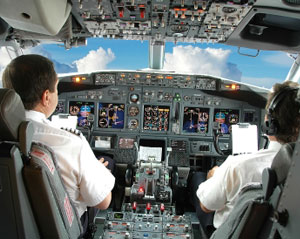Airline Pilot Jobs
Airline pilots enjoy what may be the most glamorous position of all airline jobs, and it is a reputation that is deserved. Pilots must comply with some of the strictest employment requirements of all industry workers, including extensive training, rigid physical and health conditions, and continuous retraining and testing.
Once you land a job as a pilot you’ll enjoy the rewards that you’ve earned from your years of training. As is the case with flight attendant jobs, you’ll be able to arrange your flight schedule to allow maximum free time. On a daily basis you’ll be able to run your own show. Pilots enjoy freedom and autonomy like no one else in the industry.
Commercial Pilot Jobs in Nutshell
The mental image many people associate with the word pilot typically involves a man wearing uniform, a set of wings, rolling a smallish suitcase through the airport on the way to the 757 that will take you to Boise, Idaho. However, pilots working for major airlines are only one sector of this job. Many pilots fly for the military (a great way to get flight hours, experience, and education).
Many others work in general aviation (smaller aircraft) and still others are flight instructors.
According to the Bureau of Labor Statistics, civilian aircraft pilots and flight engineers hold about 120,000 jobs. About 78,000 work as airline pilots, copilots, and flight engineers. The rest were commercial pilots who worked as flight instructors at local airports for flight schools or for large businesses that fly company cargo and executives in their own airplanes or helicopters.

The median annual wage of an airline pilot or co-pilot is approximately $114,000. Other pilot jobs include flying smaller aircraft for private corporations, transporting cargo, dusting crops, fighting fires, and even flying helicopters for law enforcement (tracking criminals). Due to the pay advantage the airlines offer, there is tremendous competition for jobs as airline pilots, which allows the major carriers to be very selective about who they hire, and they like experienced pilots who have already accumulated a lot of hours in the air.
Pilots usually start with smaller commuter and regional airlines to get they experience they need to move into airline pilot jobs. Others work as flight instructors, building up hours and increasing their certifications. As they become more experienced, these pilots occasionally fly charter planes or get jobs with small air transportation firms, such as air-taxi companies. Some move on to flying corporate planes. A small number get flight engineer jobs with the airlines.
Once in the airlines, advancement is well-regulated by union contracts and is mostly based on seniority. According to the BLS, “After 1 to 5 years, flight engineers advance according to seniority to first officer and, after 5 to 15 years, to captain. Seniority also determines which pilots get the more desirable routes. In a non-airline job, a first officer may advance to captain and, in large companies, to chief pilot or director of aviation in charge of aircraft scheduling, maintenance, and flight procedures.”
The BLS anticipates nearly 15% growth in employment for aircraft pilots and flight engineers through the year 2018. Growth is expected to be higher at regional airlines and low-cost carriers. The growth is unpredictable, however, and cyclical downturns can lead to pilot furloughs (these happened on a large scale after 9/11) Since the airlines always have such a large pool of candidates for a small number of positions, they prefer to hire pilots with the largest number of hours of flight experience, and with more experience working on high-tech equipment. Due to these preferences, pilots transitioning out of the military often have the best advantage.
- Pilot Job Description: Pilots are responsible for safely conducting their planes, passengers and cargo from one destination to another.
- Work Environment: Though the travel is a major benefit of the job, it also means a lot of time spent away from home since many flights have overnight layovers.
- Pilot Job Requirements: Licensure. “To qualify for FAA licensure, applicants must be at least 18 years old and have at least 250 hours of flight experience…Applicants also must pass a strict physical examination to make sure that they are in good health and have 20/20 vision with or without glasses, good hearing, and no physical handicaps that could impair their performance. They must pass a written test that includes questions on the principles of safe flight, navigation techniques, and FAA regulations, and must demonstrate their flying ability to FAA or designated examiners.” Source: BLS https://www.bls.gov/ooh/transportation-and-material-moving/airline-and-commercial-pilots.htm
IFR rating. In order to fly in bad weather or other low-visibility conditions, pilots must get an FAA rating to fly by instruments. To get this rating, pilots must accumulate 40 hours of experience in flying by instruments, and pass both a written and practical exam. https://www.bls.gov/ooh/transportation-and-material-moving/airline-and-commercial-pilots.htm
Airline pilots must have additional certifications: Captains have to have an airline transport pilot’s license, which requires 1,500 hours of flight experience (with night and instrument flying) and pass a written and practical exam. Most airlines also require more advanced ratings for their pilots.
Most airlines require a four-year degree from an accredited university. Whether you’re considering an aviation job in the military or a job with the airlines, a four-year aviation-related degree is always a good place to start.
Salary Range for Airline Pilots


 Teach English in Asia
Teach English in Asia  Cruise Ship Jobs
Cruise Ship Jobs  Alaska Fishing Industry Jobs
Alaska Fishing Industry Jobs  Sharing Economy / Gig Economy
Sharing Economy / Gig Economy 